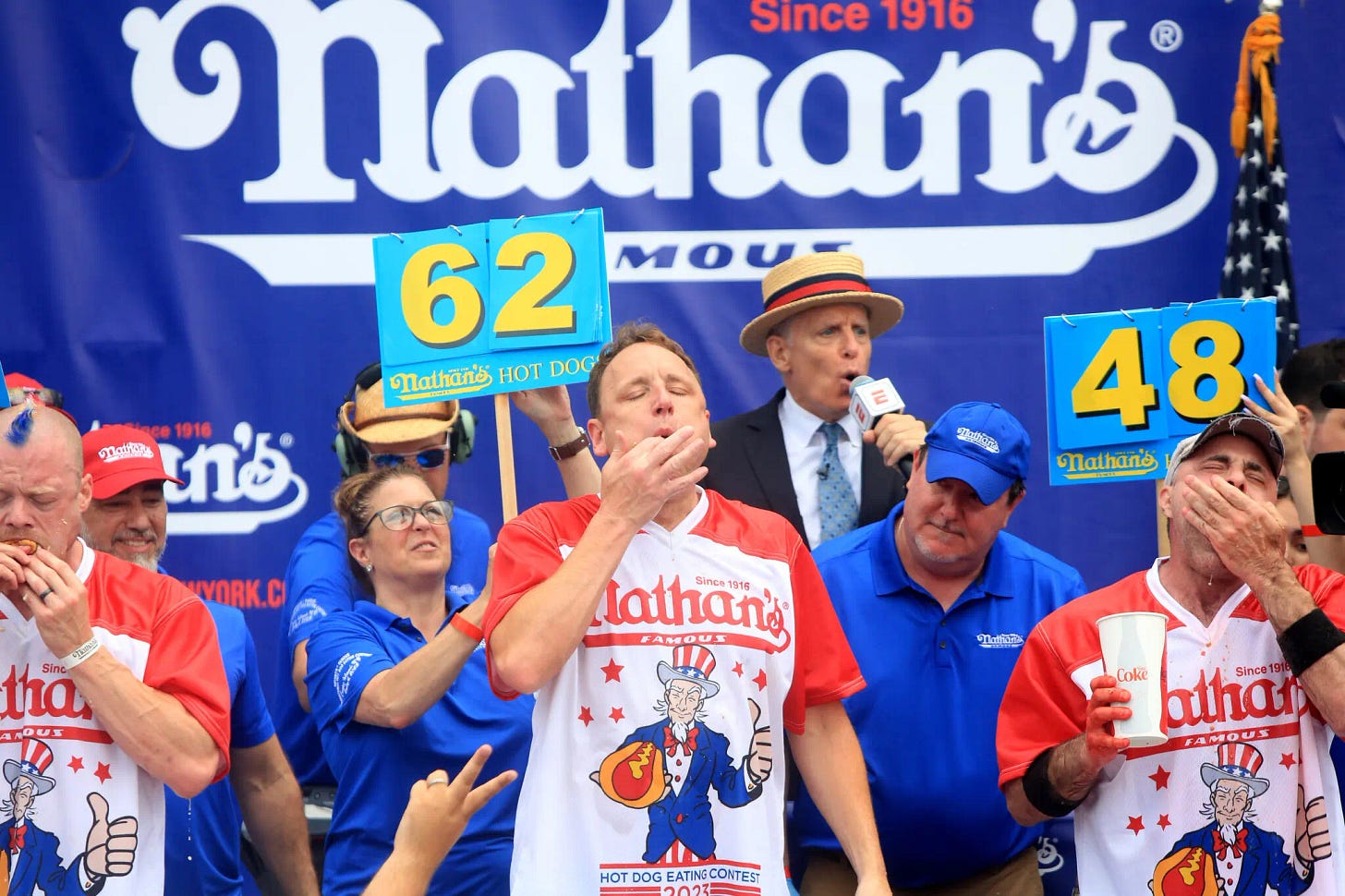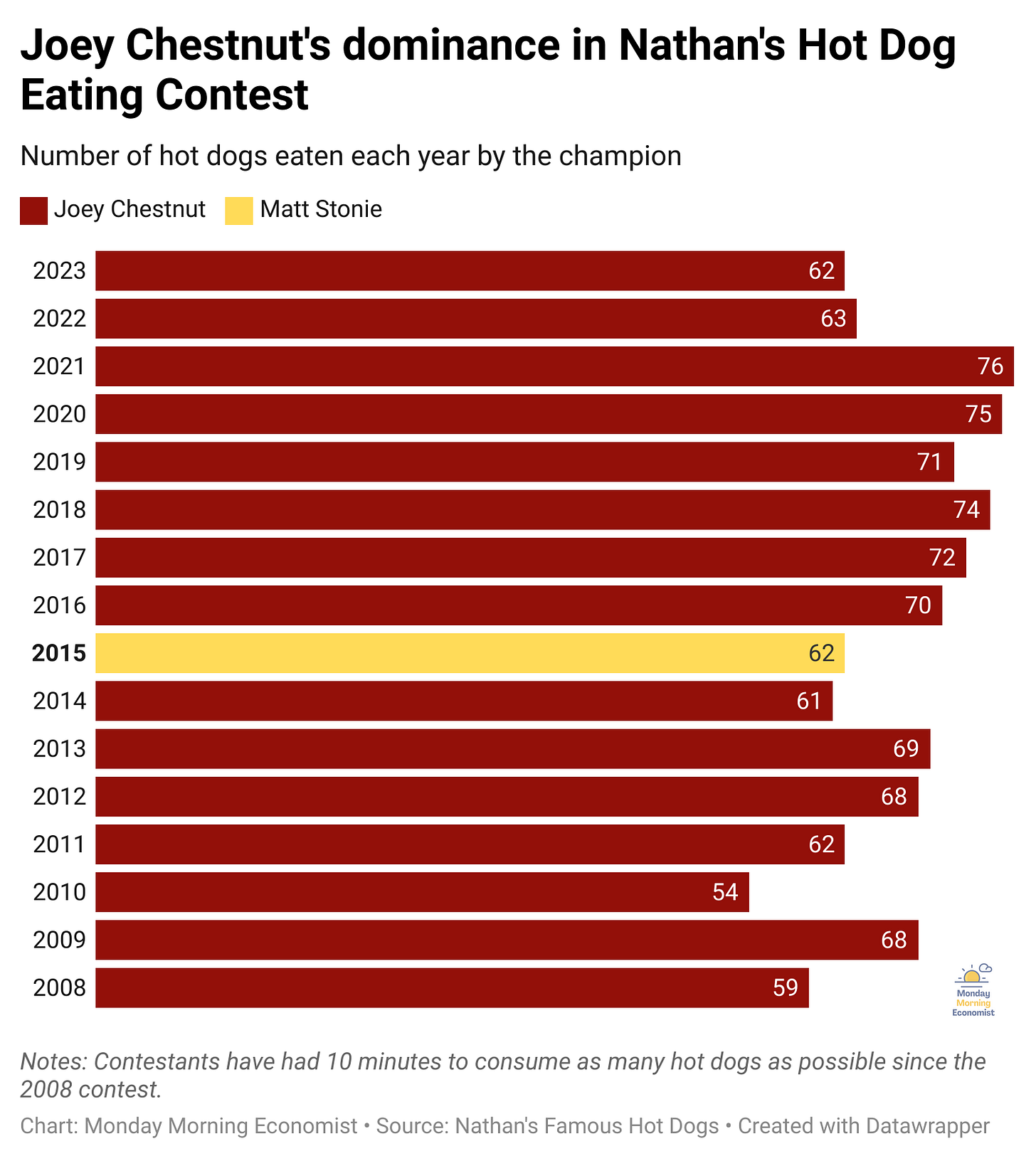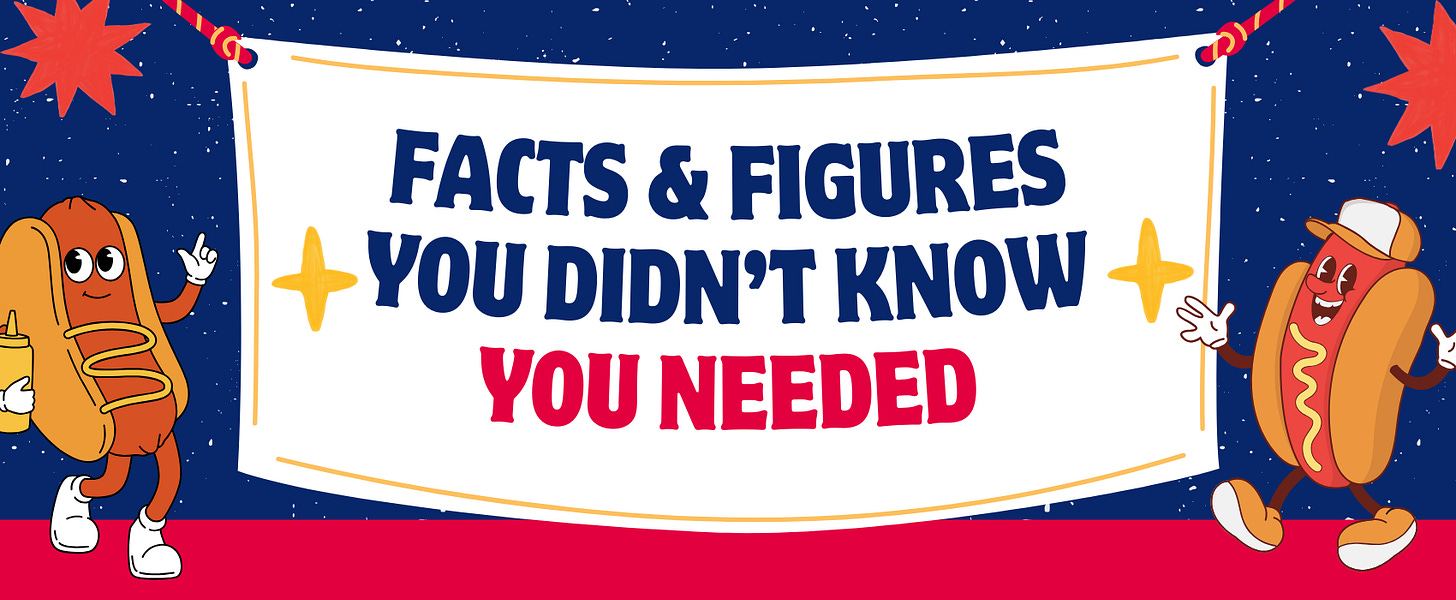Competitive Eaters Experience Diminishing Returns, Too!
Even without Joey Chestnut in this year's Nathan's Hot Dog Eating Contest, diminishing returns will "ketchup" to all the eaters at some point in the contest.
You're reading Monday Morning Economist, a free weekly newsletter that explores the economics behind pop culture, sports, and current events. It reaches thousands of curious readers every week. If you enjoy posts like this, you can support the newsletter by sharing it with a friend or becoming a paid subscriber:

The Fourth of July is just a few days away, which means the Nathan’s Hot Dog Eating Contest is just a few days away! For the uninitiated, this annual event showcases competitive eaters devouring as many hot dogs as possible in just ten minutes. It’s a display of sheer stomach-stretching prowess that captivates audiences every year.
But there’s a twist for the 2024 competition! Joey Chestnut, the reigning champion and legend of competitive eating, will not be on the stage in Coney Island. His recent endorsement with Impossible Foods means he won’t participate, leaving the competition open for a change. But while fans may miss Chestnut’s performance, his absence won’t change a fundamental economic concept affecting all the remaining competitive eaters on stage: diminishing marginal returns.
We can see diminishing returns in a variety of contexts, from manufacturing to farming, and yes, even competitive eating. Whether you’re chowing down at your backyard BBQ or watching the greatest competitive eaters of the year, diminishing returns come for us all. Simply put, diminishing returns occur when the incremental gains decrease after adding more of a particular input, such as time, effort, or resources. In the case of competitive eating, we can see this concept unfold as eaters try to consume as many hot dogs as they can within a fixed time constraint.
Explaining Diminishing Returns
Let’s break down this concept a bit more. Imagine you’re at your favorite buffet, and you’re determined to get your money’s worth. You start strong, loading your plate with all your favorite dishes. The first plate is heavenly. You go back for seconds, and it’s still good. By the time you hit your third plate, you start feeling uncomfortable. Your stomach is getting full, and each additional bite doesn’t make you quite as happy as those first few bites. That’s diminishing returns in action.
Diminishing returns happen when we keep adding more of one input while holding others constant, and the additional output we get starts to decline. Think about an assembly line at a sandwich shop: if you keep adding workers to the production line without increasing the number of refrigerators, eventually, those workers will start getting in each other’s way. The same principle applies to our competitive eaters as each minute passes.
Diminishing Returns During Nathan’s Contest
Let’s focus on the Nathan’s Hot Dog Eating Contest. Competitors have ten minutes to eat as many hot dogs as possible. At the start, they’re fresh, their stomachs are empty, and their pace is fast. But as time winds down, they start to slow down. Even the absolute best competitors can’t overcome diminishing returns.
Let’s look at Joey Chestnut’s performance in the 2023 contest in two-minute increments to make it easier. In the first two minutes, Chestnut devoured an astonishing 19 hot dogs! But he managed to consume only 15 more in the next two-minute block. That’s still impressive, but a clear drop from what he did in the first two minutes. In the third segment, he added 11 more hot dogs to his total, followed by 9 more in the fourth block of time, and finally, 8 dogs in the last two minutes before time expired. Despite his best efforts, Chestnut’s total consumption increased at a decreasing rate.
Diminishing Returns in Other Places
Competitive eating turns out to be a good case for diminishing returns because the product (hot dogs and buns) is easily countable. This makes it straightforward to quantify and analyze when diminishing returns kick in. But this principle extends far beyond the Nathan’s Hot Dog Eating Contest.
Let’s say you want to impersonate Joey Chestnut at your backyard cookout this year. At first, you might quickly consume several hot dogs, but as you continue, each additional hot dog becomes more challenging to eat. Eventually, you reach a point where the thought of consuming another hot dog is nearly unbearable. The total number of hot dogs you’ve eaten will increase as time ticks away, but the rate at which you can continue eating decreases. You are just like Joey Chestnut… sort of!
If you’re not up for a gastronomical challenge this year, consider the experience of watching a well-choreographed fireworks show. The first minute or two of the show is filled with excitement and awe as the sky lights up with bursts of color. As the show continues, your overall enjoyment increases, but perhaps not as intensely as during those initial moments. If the show goes on for too long, you might even start to wonder when it will end. That’s diminishing returns, too.
Final Thoughts
The concept is all around us and influences many aspects of our day-to-day lives. If you can understand this concept, it can help make sense of why enjoyment or productivity tends to taper off after a certain point. Whether that’s studying for an exam, binge watching old episodes of The Office, or cleaning up around the house. It’s a concept that should remind us that more isn’t always better, and sometimes, the best experiences and outcomes come in the early stages.
But in case you’ve forgotten this point, the Nathan’s Hot Dog Eating Contest provides an entertaining way to visualize this economic principle every summer. If you’re tuning in this summer, pay attention to how the initial burst of consumption slows down as the contest progresses.
Even the most skilled competitive eaters face the same limitations you and I would experience. Their threshold doesn’t kick in until way later. As you enjoy your hot dogs this holiday, remember that each bite is a lesson in economics.
The Nathan's Famous International Hot Dog Eating Contest attracts over 40,000 fans each year and is broadcast on ESPN to nearly 2 million viewers [Nathan’s Famous Hot Dogs]
Annual U.S. grocery and related sales of “meat alternatives” declined from $484 million in 2020 to $318 million last year, a 32% drop [MorningStar]
Joey Chestnut won the 2023 competition by consuming 62 hot dogs and buns, beating the second-place finisher by 13 hot dogs. [Sporting News]
Joey "Jaws" Chestnut holds world records for eating 56 different foods, ranging from funnel cakes to pierogis [Major League Eating]
In 2021, Chestnut set the hot dog eating record by consuming 76 hot dogs and buns in just 10 minutes. [CNN]







"You are just like Joey Chestnut, sort of!"
Hey, I didn't earn a body like this by only eating when I was hungry